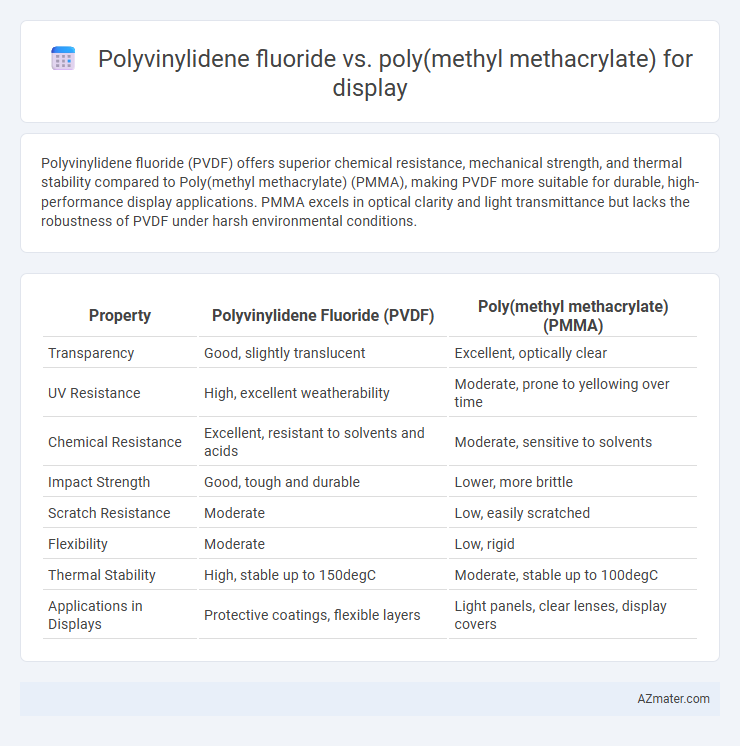Polyvinylidene fluoride (PVDF) offers superior chemical resistance, mechanical strength, and thermal stability compared to Poly(methyl methacrylate) (PMMA), making PVDF more suitable for durable, high-performance display applications. PMMA excels in optical clarity and light transmittance but lacks the robustness of PVDF under harsh environmental conditions.
Table of Comparison
| Property | Polyvinylidene Fluoride (PVDF) | Poly(methyl methacrylate) (PMMA) |
|---|---|---|
| Transparency | Good, slightly translucent | Excellent, optically clear |
| UV Resistance | High, excellent weatherability | Moderate, prone to yellowing over time |
| Chemical Resistance | Excellent, resistant to solvents and acids | Moderate, sensitive to solvents |
| Impact Strength | Good, tough and durable | Lower, more brittle |
| Scratch Resistance | Moderate | Low, easily scratched |
| Flexibility | Moderate | Low, rigid |
| Thermal Stability | High, stable up to 150degC | Moderate, stable up to 100degC |
| Applications in Displays | Protective coatings, flexible layers | Light panels, clear lenses, display covers |
Introduction to Display Materials
Polyvinylidene fluoride (PVDF) offers excellent chemical resistance and thermal stability, making it suitable for durable, high-performance display components. Poly(methyl methacrylate) (PMMA) is prized for its superior optical clarity and lightweight properties, enhancing brightness and color accuracy in display panels. Selection between PVDF and PMMA depends on the balance required between mechanical robustness and optical transparency for specific display applications.
Overview of Polyvinylidene Fluoride (PVDF)
Polyvinylidene fluoride (PVDF) is a highly non-reactive and pure thermoplastic fluoropolymer known for its excellent chemical resistance, mechanical strength, and thermal stability, making it ideal for demanding display applications. PVDF films exhibit superior dielectric properties and UV resistance, contributing to enhanced durability and performance in flexible and rigid display technologies. Its piezoelectric and pyroelectric characteristics enable multifunctional use in smart displays, sensors, and touchscreens.
Introduction to Poly(methyl methacrylate) (PMMA)
Poly(methyl methacrylate) (PMMA) is a transparent thermoplastic widely used in display technologies due to its excellent optical clarity, high light transmittance (up to 92%), and superior weather resistance. PMMA offers good mechanical strength and surface hardness, making it suitable for touchscreens and protective display covers. Its flexibility in processing and ability to maintain dimensional stability under varying temperatures make it a preferred choice over Polyvinylidene fluoride (PVDF) for applications requiring clear, durable display surfaces.
Optical Properties: Clarity and Light Transmission
Polyvinylidene fluoride (PVDF) exhibits moderate clarity and light transmission, making it suitable for applications requiring chemical resistance and durability but less ideal for high-clarity optical displays. Poly(methyl methacrylate) (PMMA) offers superior optical properties with exceptional clarity and light transmission above 92%, providing vibrant color display and minimal distortion. PMMA's low haze and high transparency make it the preferred choice for display technologies demanding clear, bright visuals.
Mechanical Strength and Durability Comparison
Polyvinylidene fluoride (PVDF) exhibits superior mechanical strength and durability compared to Poly(methyl methacrylate) (PMMA), making it highly suitable for demanding display applications. PVDF offers excellent impact resistance and maintains structural integrity under harsh environmental conditions, including UV exposure and temperature fluctuations. In contrast, PMMA, while optically clear and lightweight, is more susceptible to scratches, cracking, and degradation over time, limiting its long-term durability in display technology.
Electrical and Piezoelectric Performance
Polyvinylidene fluoride (PVDF) exhibits superior piezoelectric properties compared to Poly(methyl methacrylate) (PMMA), making it ideal for display applications requiring mechanical-to-electrical energy conversion. PVDF's high dielectric constant and polarization enhance its electrical responsiveness, while PMMA, with lower dielectric strength, serves better as a transparent substrate rather than an active piezoelectric material. The significant remanent polarization and electromechanical coupling coefficients of PVDF contribute to its dominance in flexible, high-performance piezoelectric display technologies.
Thermal Stability in Display Applications
Polyvinylidene fluoride (PVDF) exhibits superior thermal stability compared to Poly(methyl methacrylate) (PMMA), making it more suitable for high-temperature display applications. PVDF withstands temperatures up to approximately 150degC without significant degradation, whereas PMMA typically degrades around 100degC, limiting its use in displays requiring prolonged heat resistance. This enhanced thermal durability ensures PVDF maintains optical clarity and mechanical integrity, essential for advanced display technologies.
Processability and Manufacturing Considerations
Polyvinylidene fluoride (PVDF) offers excellent chemical resistance and thermal stability, making it ideal for durable display applications with rigorous manufacturing environments. Poly(methyl methacrylate) (PMMA) excels in optical clarity and ease of molding but has lower thermal resistance, which can limit its use in high-temperature manufacturing processes. PVDF's superior processability in extrusion and film casting ensures consistent performance in flexible displays, whereas PMMA is preferred for rigid display components requiring high transparency.
Cost-Effectiveness: PVDF vs PMMA
Polyvinylidene fluoride (PVDF) offers superior chemical resistance and durability compared to Poly(methyl methacrylate) (PMMA), making it cost-effective for long-term display applications despite higher initial costs. PMMA provides excellent optical clarity and lower upfront expenses but may incur increased maintenance or replacement costs due to lower weather resistance. Choosing PVDF ensures reduced lifecycle costs and enhanced performance in demanding display environments.
Application Suitability and Future Trends
Polyvinylidene fluoride (PVDF) offers superior chemical resistance, mechanical strength, and electroactive properties, making it highly suitable for flexible and durable display substrates in advanced touchscreen and OLED applications. Poly(methyl methacrylate) (PMMA) provides excellent optical clarity and ease of processing but falls short in flexibility and environmental stability compared to PVDF, limiting its use mainly to rigid, non-flexible display components. Emerging trends indicate growing adoption of PVDF in next-generation flexible displays and wearable electronics due to its robustness and piezoelectric capabilities, while PMMA continues to serve cost-sensitive applications with high transparency requirements.

Infographic: Polyvinylidene fluoride vs Poly(methyl methacrylate) for Display
 azmater.com
azmater.com